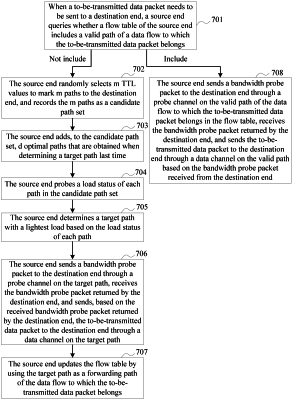| CPC H04L 47/125 (2013.01) [H04L 43/10 (2013.01); H04L 47/115 (2013.01); H04L 47/283 (2013.01)] | 21 Claims |

|
1. A load balancing method, comprising:
recording one or more d paths that were used as a previous target path from a source end to a destination end;
performing random selection on a first group of paths by randomly selecting m paths from the first group of paths, wherein the first group of paths are all paths between the source end and the destination end;
adding the one or more d paths to the m paths to determine n paths, wherein a first quantity of the n paths is less than a second quantity of the all paths and greater than a third quantity of the m paths;
selecting the n paths;
selecting, based on load statuses of respective probe channels on the n paths, a current target path with a lightest load in the n paths, wherein each of the respective probe channels is for transmitting a probe packet, wherein the probe packet comprises a bandwidth probe packet, and wherein n is an integer greater than 1;
sending, subsequent to and based on selecting the current target path, the bandwidth probe packet to the destination end through a first probe channel on the current target path, wherein the first probe channel is selected from the respective probe channels;
receiving, subsequent and responsive to the sending, the bandwidth probe packet from the destination end; and
sending, in response to receiving the bandwidth probe packet from the destination end, a to-be-transmitted data packet to the destination end through a data channel on the current target path.
|